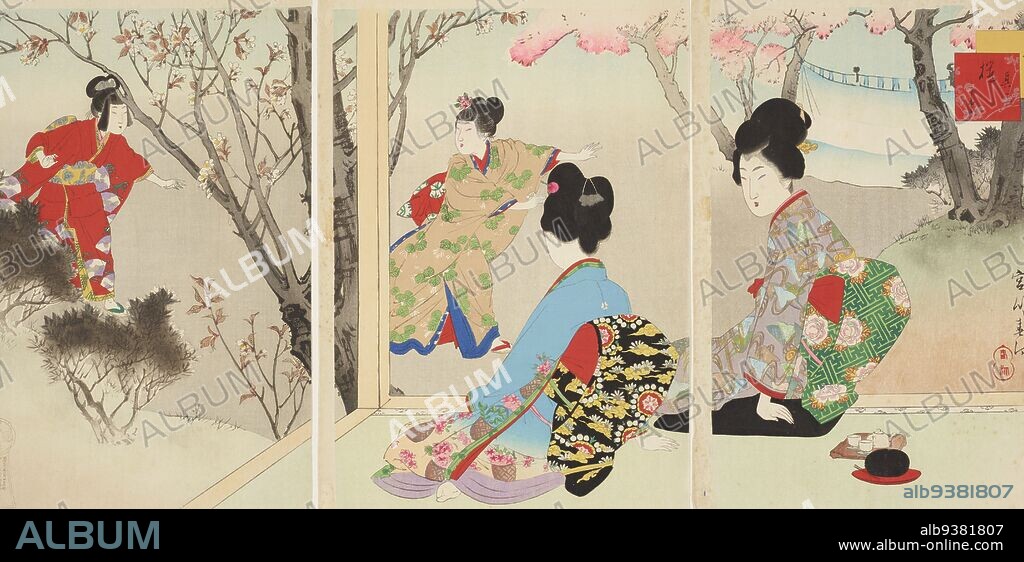alb9381807
Bijin Junikagetsu (Beauties in the twelve months): March, Miyagawa Shuntei, artist, 1898, Tokyo, woodcut, Miyagawa Shuntei (1873-1914) was a specialist in kuchi-e (literally: mouth piece frontispiece prints) which heralded a new discourse on the social construction of girlhood and womanhood in its focus on sentimental Western notions of romantic love in Japan. He worked in a neo-traditional ukiyo-e mode, evocative of the past but making obvious to anyone that his prints were from the turn of the century. In compositions reminiscent of earlier Yamato-e Japanese-picture genre scenes, Shuntei celebrates the worlds of middle-class women and children at leisure. These themes are reflected in print series titles like Customs of Children (1896) and his celebrated triptych series Bijin junikagetsu (Beauties in the twelve months). In each of the latter series, Shuntei depicts groups of women and children gathering shells and swimming, enjoying picnics in gardens, playing games, and enjoying the changing seasons according to the month. Te Papa acquired three of these compositions from the Heriot collection.

|
Add to another lightbox |
|
Add to another lightbox |



Caption:
Bijin Junikagetsu (Beauties in the twelve months): March, Miyagawa Shuntei, artist, 1898, Tokyo, woodcut, Miyagawa Shuntei (1873-1914) was a specialist in kuchi-e (literally: mouth piece frontispiece prints) which heralded a new discourse on the social construction of girlhood and womanhood in its focus on sentimental Western notions of romantic love in Japan. He worked in a neo-traditional ukiyo-e mode, evocative of the past but making obvious to anyone that his prints were from the turn of the century. In compositions reminiscent of earlier Yamato-e Japanese-picture genre scenes, Shuntei celebrates the worlds of middle-class women and children at leisure. These themes are reflected in print series titles like Customs of Children (1896) and his celebrated triptych series Bijin junikagetsu (Beauties in the twelve months). In each of the latter series, Shuntei depicts groups of women and children gathering shells and swimming, enjoying picnics in gardens, playing games, and enjoying the changing seasons according to the month. Te Papa acquired three of these compositions from the Heriot collection.
Credit:
Album / quintlox
Releases:
Model: No - Property: No
Rights questions?
Rights questions?
Image size:
5940 x 2950 px | 50.1 MB
Print size:
50.3 x 25.0 cm | 19.8 x 9.8 in (300 dpi)
Keywords:
1873-1914 • 1896 • 1898 • ADOLESCENCE • ANYONE • ARTIST • ARTISTE • BEAUTIES • BIJIN JUNIKAGETSU • BOY • BOYS • CELEBRATED TRIPTYCH SERIES BIJIN JUNIKAGETSU • CENTURY • CHANGING SEASONS ACCORDING • CHILD • CHILDHOOD • CHILDREN GATHERING SHELLS • CHILDREN • COMPOSITIONS REMINISCENT • COMPOSITIONS • COURTYARD • CUSTOMS • EARLIER YAMATO-E JAPANESE-PICTURE GENRE SCENES • ENJOYING PICNICS • ENJOYING • EVOCATIVE • FOCUS • FOCUSING • FREE TIME • GARDEN • GARDENS • GIRLHOOD • HERALDED • HERIOT COLLECTION • INFANT • JAPAN • JAPANESE • KID • KIDS • KUCHI-E • LATTER SERIES • LEISURE TIME • LEISURE • LITERALLY • LITTLE GIRL • MARCH (MONTH) • MARCH • MIDDLE-CLASS WOMEN • MIYAGAWA SHUNTEI • MONTH • MOUTH PIECE FRONTISPIECE PRINTS • NEO-TRADITIONAL UKIYO-E MODE • NEW DISCOURSE • OBVIOUS • OFFSPRING • PARK • PAST • PATIO • PLAYING GAMES • PRINT SERIES TITLES • PRINTS • REFLECTED • ROMANTIC LOVE • SENTIMENTAL WESTERN NOTIONS • SHUNTEI CELEBRATES • SHUNTEI DEPICTS GROUPS • SOCIAL CONSTRUCTION • SPECIALIST • SWIM • SWIMMING • TE PAPA ACQUIRED THREE • THEMES • TOKYO • TURN • TWELVE MONTHS • WOMAN'S • WOMAN • WOMANHOOD • WOMEN'S • WOMEN • WOMENS • WOODBLOCK PRINT • WOODCUT • WORKED • WORLDS • XYLOGRAPHY • YARD • YOUTH
 Pinterest
Pinterest Twitter
Twitter Facebook
Facebook Copy link
Copy link Email
Email

